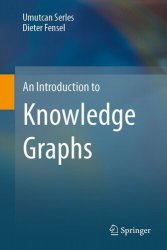An Introduction to Knowledge Graphs
- Добавил: literator
- Дата: 9-06-2024, 20:24
- Комментариев: 0
 Название: An Introduction to Knowledge Graphs
Название: An Introduction to Knowledge GraphsАвтор: Umutcan Serles, Dieter Fensel
Издательство: Springer
Год: 2024
Страниц: 440
Язык: английский
Формат: pdf (true)
Размер: 28.4 MB
This textbook introduces the theoretical foundations of technologies essential for knowledge graphs. It also covers practical examples, applications and tools. Knowledge graphs are the most recent answer to the challenge of providing explicit knowledge about entities and their relationships by potentially integrating billions of facts from heterogeneous sources.
The standard narrative about the recent history of Artificial Intelligence (AI) is that a combination of rapidly growing compute power and an immense increase in available data have caused a scaling explosion in AI that has led to the results in Machine Learning (ML) in the past decade. Indeed, this narrative is true, and the results of the ML explosion are clear for all to see, in the popular press, in scientific publications, and in real world applications, ranging from product recommendation to fraud detection and from chatbots to face recognition.
What is rather less known to the general public, the popular press, and indeed in AI itself is that a similar scaling explosion has taken place in another area of AI. By the end of the 1990s, a knowledge base of a few thousand facts and rules was considered large. But nowadays, we routinely manipulate knowledge bases that contain billions of facts, describing hundreds of millions of entities, using an ontology of many thousands of statements.
The main driver for this “other explosion” of size in AI has been the adoption of the knowledge graph model, combined with ontology languages that carefully balance expressivity against computational cost. Knowledge graphs now form the biggest knowledge bases ever built, and without a doubt, languages like RDF Schema and OWL are by far the most widely used knowledge representation languages in the history of AI.
And these knowledge graphs have come of age. They are used in science, in public administration, in cultural heritage, in healthcare, and in a broad range of industries, ranging from manufacturing to financial services and from search engines to pharmaceuticals.
The book is structured in four parts. For a start, Part I lays down the overall context of knowledge graph technology. Part II “Knowledge Representation” then provides a deep understanding of semantics as the technical core of knowledge graph technology. Semantics is covered from different perspectives, such as conceptual, epistemological and logical. Next, Part III “Knowledge Modelling” focuses on the building process of knowledge graphs. The book focuses on the phases of knowledge generation, knowledge hosting, knowledge assessment, knowledge cleaning, knowledge enrichment, and knowledge deployment to cover a complete life cycle for this process. Finally, Part IV (simply called “Applications”) presents various application areas in detail with concrete application examples as well as an outlook on additional trends that will emphasize the need for knowledge graphs even stronger.
This textbook is intended for graduate courses covering knowledge graphs. Besides students in knowledge graph, Semantic Web, database, or information retrieval classes, also advanced software developers for Web applications or tools for Web data management will learn about the foundations and appropriate methods.
Скачать An Introduction to Knowledge Graphs
Внимание
Уважаемый посетитель, Вы зашли на сайт как незарегистрированный пользователь.
Мы рекомендуем Вам зарегистрироваться либо войти на сайт под своим именем.
Уважаемый посетитель, Вы зашли на сайт как незарегистрированный пользователь.
Мы рекомендуем Вам зарегистрироваться либо войти на сайт под своим именем.
Информация
Посетители, находящиеся в группе Гости, не могут оставлять комментарии к данной публикации.
Посетители, находящиеся в группе Гости, не могут оставлять комментарии к данной публикации.
